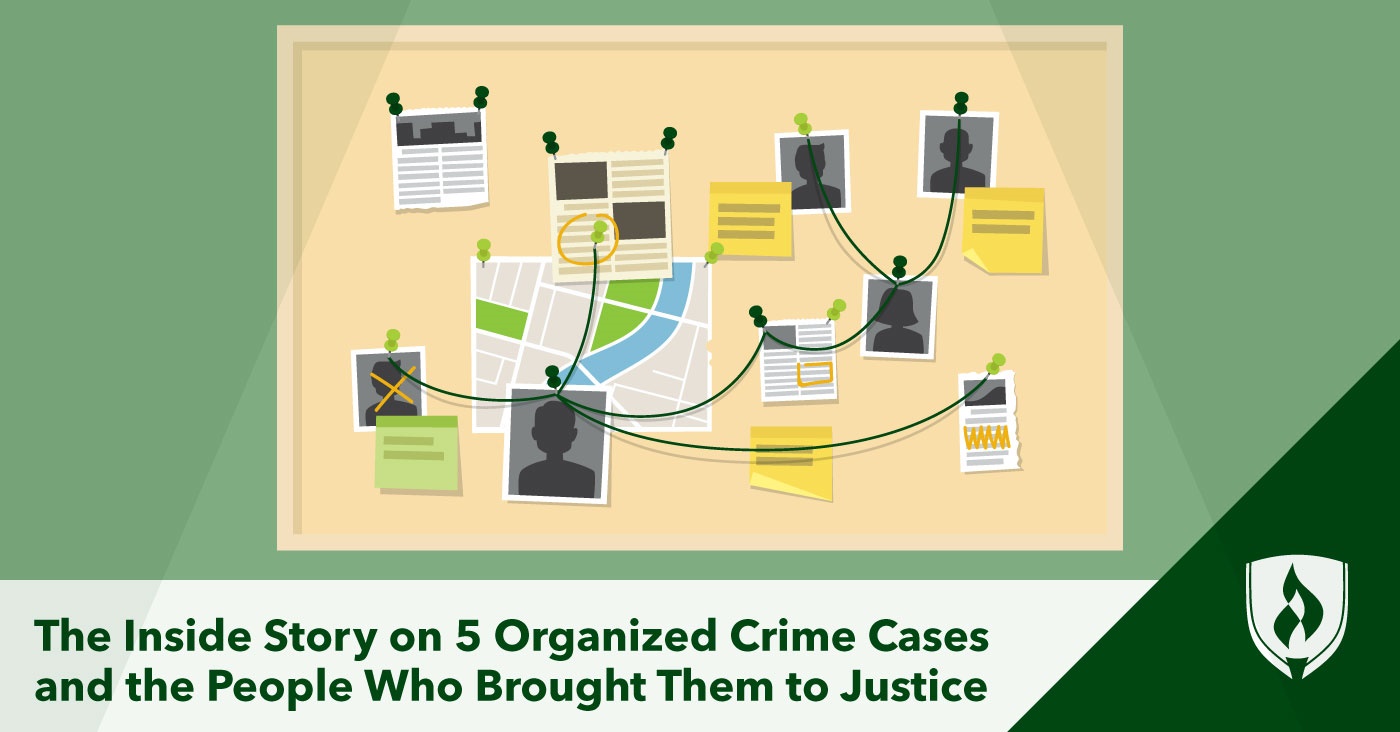The Inside Story on 5 Organized Crime Cases and the People Who Brought Them to Justice
By Kirsten Slyter on 10/18/2021

There’s no question that organized crime is a fascinating topic. Hit Hollywood depictions like Goodfellas, The Departed and The Sopranos have firmly established themselves as a part of American popular culture. While these depictions may paint individual members of organized crime rings in a sometimes-favorable light, organized crime remains a substantial problem that leads to a lot of suffering for those caught up in their web.
These organizations are committed to ill-gotten profits and power. Some boast huge numbers and often the takedowns of even key figures aren’t enough to stop the group from carrying on. It takes a lot of resources, manpower and smarts on the law enforcement side to catch and convict these criminals.
In this article, we’ll walk through some well-known—and not-so-well-known—organized crime cases where law enforcement was able to get the upper hand and explain how they did it.
What is organized crime?
But first, let’s start with defining organized crime. According to the FBI, organized crime is the associations of individuals who operate illegally to gain power, influence and wealth. Organized crime enterprises can be organized by clans, networks or hierarchies. They’re often involved in crimes like:
- Drug trafficking
- Human trafficking
- Firearms trafficking
- Illegal gambling
- Extortion
- Cybercrime
- Migrant smuggling
Though groups organized via local ethnic ties (like the Mafia or the Westies) are well-known, criminal enterprises can do their work all across the world thanks to international ties and the Internet.
Often, the FBI in the U.S works to breakdown international and national organized crime enterprises by using the Racketeer Influenced and Corrupt Organizations statue (RICO act). Passed in 1970, this act gives authorities more leverage to pursue civil and criminal penalties for racketeering activity against groups of people working as part of an on-going criminal enterprise.
In the cases that follow, you’ll see more specific actions taken by law enforcement to catch and convict individuals in organized crime enterprises.
A closer look at 5 fascinating organized crime cases
1. The St. Valentine’s Day Massacre and Capone’s downfall
February 14, 1929, is known as the date of one of the most violent events ever to occur in Chicago gang history. The infamous Al Capone and George “Bugs” Moran ran opposing enterprises on the north and south sides of Chicago, respectively. Capone made huge sums of money through bootlegging, speakeasies, gambling and prostitution through the 1920s and sought to consolidate the gangs of Chicago to increase his personal wealth.
On February 14, seven members of Moran’s gang were brutally gunned down in a parking garage in the Lincoln Park neighborhood. Over 70 rounds of ammunition were fired. When police arrived at the scene, only one gang member was found alive. He later succumbed to his injuries in the hospital.
Eyewitness reported that two men dressed as police officers and two in plain clothes entered the garage and pretended to arrest the men in the garage, but instead shot them. Moran himself was meant to be at the garage, but on the way, he saw the men dressed as police officers and decided to stop for coffee instead, saving his own life.
Though no one was ever brought to trial for the murders, Al Capone was eventually put in prison for income tax evasion thanks to diligent forensic accounting by special agent Frank Wilson and other members of the Intelligence Unit of the Internal Revenue Service. Wilson and the others reviewed over two million documents to find several ledgers containing income that Capone had not reported. He was convicted and sentence to eleven years in prison, in addition to $80,000 in fines and court costs.
2. Operation Trojan Shield
Operation Trojan Shield was put into effect in just 2018. The international effort, coordinated by the FBI, resulted in more than 800 arrests. A search warrant affidavit filled by an FBI Special Agent in San Diego allowed the FBI to identify over 300 transnational criminal organization using a platform called ANOM, run with collaboration by the FBI.
Traffickers and criminals used ANOM devices and platforms to send encrypted messages planning and coordinating their activities. They didn’t know copies of those same messages were sent to the FBI, the Australian Federal Police and other agencies. Those agencies gathered over 27 million messages.
This international effort was able to show connections around the world. Because of the messages, Australian Federal Police were able disrupt 20 threats to kill people. Authorities in Europe seized more than 8 tons of cocaine, 22 tons of cannabis and several tons of other drugs, along with 55 luxury vehicles and over $48 million in various worldwide currencies and cryptocurrencies.
3. United States v Antony Salerno, et al (The Mafia commission trial)
This 1986 trial is known as one of the most significant blows to organized crime in the United States. Formerly confidential information about the Mafia’s internal organization was revealed, and eight defendants were convicted of racketeering including some of the “dons” and underbosses of New York’s five most-prominent crime families, also known as “the Commission” or “La Cosa Nostra.”
The court indictments were the products of five years of investigations, 171 court-authorized wiretaps and the work of more than 200 federal agents. By the time the trial started, there were more than 25 indictment counts including charges of extortion, narcotics, gambling, labor racketeering and murder.
One of the most dramatic moments of the trial occurred when Angelo Lonardo, former Cleveland mafia underboss, took the stand and broke the Mafia’s “omerta” code of silence. Lonardo had been offered a deal by the FBI—testimony in exchange for a reduced sentence and possible parole for his own conviction on drug charges. He provided insights into how the Commission operated. Lonardo’s family in Cleveland communicated to the Commission via Tony Salerno. He pointed out Salerno in court and called out Salerno as the current boss of the Genovese crime family.
The ten-week trial ended with eight convictions of involvement in the Commission and more specific criminal acts from the Genovese, Lucchese, Colombo and Bonanno families.
4. Kansas City Massacre
This June 17, 1933, massacre took the lives of four FBI agents and their federal prisoner, Frank Nash, outside the Union Railway Station in Kansas City, Missouri. Nash already had a long history of criminal activity and was being brought back to a U.S. penitentiary after escaping.
The four individuals indicted of the shooting were said to have connections with Nash in the crime world and didn’t want him sharing potentially damning information with law enforcement. The four individuals—Richard Galatas, Herbert Farmer, “Doc” Louis Stacci and Frank Mulloy—were found guilty of conspiracy to cause the escape of a federal prisoner from the custody of the United States. Each were sentenced to serve two years in a federal penitentiary and pay a fine of $10,000, the maximum penalty allowed by law at the time.
The events of the Kansas City Massacre changed the operations of the FBI. Before, the agency wasn’t permitted to carry firearms or make arrests. After the massacre, Congress gave the FBI statuary authority to carry guns and make arrests, making FBI agents much closer to what they are today.
5. Operation Family Secrets
This seven-year investigation is known as one of the most successful organized crime law enforcement efforts ever conducted. It all started when a letter arrived at the Chicago FBI office from Frank Calabrese Jr. in prison. Calabrese Jr. wanted to help put his father, a mobster, away for life. Nick Calabrese, Frank’s brother, also became an informant.
The investigation led to indictments among 14 defendants affiliated with the Chicago outfit, the Windy City’s mafia organization. Eighteen murders and one attempted murder were investigated with the rest of the crimes encompassing loansharking and bookmaking.
Throughout the 2007 trial, more than 125 witnesses and 200 pieces of evidence were presented. Frank Calabrese was sentenced to life in prison for 13 slayings (among other crimes).
Could a crime-solving career be in your future?
Though we’ve explored organized crime cases with convicted criminals behind bars, many more cases stand unsolved. The world of organized crime is changing. The Mafia, cartels and other organized crime rings still exist, but catching underworld criminals today might look more like Operation Trojan Shield than hunting down mob bosses on the street. No matter how methods may change, the need to help reel in criminal behavior remains constant.
Does the thrill of the chase and the investigative nature of solving crime sound like something you could devote your career to? Our article “Investigate Your Future: Are You Destined for a Crime-Solving Career?” highlights some of the other key signs you’d thrive in an investigative role.
Related Articles:




